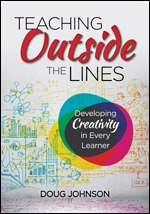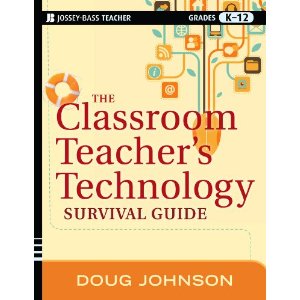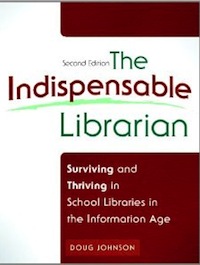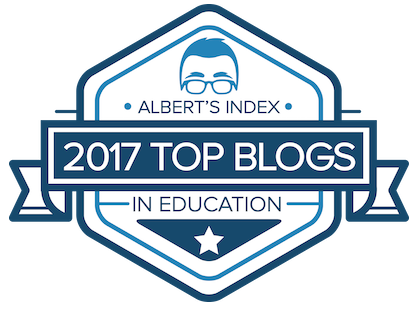Communicating with your principal
 Thursday, January 12, 2012 at 05:44AM
Thursday, January 12, 2012 at 05:44AM Note: This week I am on a "writing holiday" from my day job. I'm using the time to work on a revision of my 1997 book The Indispensable Librarian. (Personally, I think it is still just fine, but others have asked if we still use Gopher as a search tool in our district.) While I wrote the draft for my last book I took advantage of Blue Skunk readers, using you as a sounding board for my book materials. Consider yourselves so used again. Thank you. – Doug
The section below is the beginning of my chapter on Communications and Advocacy
My first relationship with a school principal was adversarial and goes back to about the second grade when I was sent to “The Office” for rendering a rather rude pencil sketch of my classroom teacher. In Iowa schools of the late 1950s, corporal punishment was not only allowed, it was encouraged.
Over the next 30 years, my view of school administrators did not improve a great deal as I moved from being a student to being a teacher to being a librarian. The worst principal I worked for often bragged that he managed to obtain his college degrees without ever setting foot in a library. I told him I could tell.
The best principal I had, I considered an agent of benevolent neglect. There was an unspoken agreement that if I left him alone, he would leave me alone.
Then I met Gil Carlson from St. Peter, Minnesota, who was convinced that a good library program would be in the best educational interests of his students. He didn’t know what all that entailed so it was up to me, he said, to educate him about what a good library program did. I did my best, and found that a principal could be a staunch ally against ignorance and textbook learning – and a firm library supporter.
But I also found that I had to do the educating. And not just of him, but of other stakeholders in the district including the staff and parents. I had to figure out how to communicate what good library programs, and especially my library program, was doing to help both the school and the individuals in it to succeed.
I also found that by keeping stakeholders apprised of what the library program was doing, I could build true advocates for the program. Self-advocacy is not particularly effective since it is also self-serving. But others can’t advocate on your behalf if they don’t know about what you do. Good communications is the key element in any successful advocacy story.
And leaving such education to chance wasn’t possible. I needed to create a real communication plan – and commit to it.
What are the components of an effective communications program?
Good communications efforts don’t just happen. They are carefully designed, implemented and evaluated for effectiveness. Communications, like assessment and planning, fall into Covey’s Quadrant II of things that are important, but not urgent, and therefore easy to never get around to doing. A good plan, however, will structure your communication efforts, give you a timeline, and increase the chances of getting them done.
Here are four steps you can take in creating a communications plan with impact.
1. Identify your audiences
Who needs to know about what your program does? What you do? Why good library programs are important to students? There are three main groups to which you should target communications: your principal, your staff and your parents.
Why not students? Yes, they also need to know about what’s happening in the library, but we tend have a lot of opportunities to inform them of what’s happening and, as a part of the school, they should already have first hand knowledge of the library and how it serves them. And unfortunately, students are rarely consulted on matters of budgets, staffing and curriculum – if ever.
1. Target your communications specifically to each group.
One advantage of having a planning document as discussed in the previous chapter is that it can serve as basis for what you communicate. Progress on the completion of your annual objectives should be of interest to all parties since input on its content came from members of each group. While you should formally report at the end of the year to the principal and advisory committee using the planning document to give an honest appraisal of how well the goals and objectives for the year were met, keeping everyone updated on progress through the year also keeps everyone mindful of the library program and the wonders it performs.
The principal
The principal is the single most important person you need to keep informed. He or she is your supervisor. He or she has control over budgets, staffing, policies, and facility use. The success or failure - even existence of your library - may depend on your principal’s view of it.
Remember that all administrators hate surprises. Your principal does not like to be surprised by either good or bad news about your library delivered by someone else. (As a true administrator myself, I like knowing of bad things in advance so I can figure out someone else to blame. I like knowing about good things in advance so I can figure out how to take the credit.) Your principal should never first hear about something happening in your library from a teacher, a student or, especially, a parent. Principals want to know everything that is going on in their buildings – both problems and successes.
A bi-monthly principal's report should cover all activities in which you are involved over a two-month period, succinctly described. These activities may include:
- Teachers whose classes are using the media center and with whom you have been cooperatively teaching (Mr. Gomez’s students worked with the new database of countries from March 12th through the 15th.)
- New resources and how they are being used (I am helping students use GoogleDocs to write their career plans.)
- In-services given or facilitated by the library staff (My after school “Techie Tuesday” in-service on how to edit and add graphics to teachers’ websites was attended by twelve staff members.)
- Special administrative tasks performed (I’ve updated the job description for our library paraprofessional to reflect new technology support responsibilities.)
- Problems encountered and how they are being dealt with (Library over-crowding during the lunch hour is being discussed at the next building leadership team meeting.)
- Circulation and media center usage figures (Over the last two months, an average of twenty books per student were circulated, the library had an average thirty-seven students per hour using it, and the library webpage was accessed 7,356 times.)
- Professional activities including workshop and conference attendance. (At the recent state library conference, I learned some online resources for the astronomy class that I’ve shared with the teachers.)
Use your library calendar and to-do list to help remind you of your previous months’ activities. Keep the reports upbeat, complimentary, and as short as possible.
There are two things to avoid in these reports. First, do not criticize teachers or students in them. Some principals may share the reports with staff. If you have problems with individuals or policies, and we all do, schedule a face-to-face meeting with your principal to discuss them. Second, do not whine. Whining is going to your supervisor with a problem about which nothing can be done. It feels good to just let it all out sometimes about things that really can’t be changed. But listening to that sort of venting is what your spouse, your mom, or your cat is there for – not your principal.
Oh, it’s a good idea to schedule a time to review these reports face-to-face after you’ve sent them out to clarify and questions or concerns.









Reader Comments